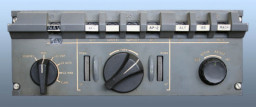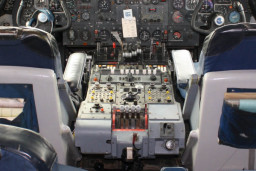From the early days of the company it had been hoped to enter the civil aircraft flight control field, in order to reduce dependence on military projects. The late 1950s was a time of significant change in the automatic flight control field. Elliott made a major contribution to this evolution by the design and development of actuation systems which integrated the electronic control input with the hydraulics of the main flying control power actuator.
The opportunity to take this step came in the late 1950’s with the planning of the Vickers 'VC 10' for which Elliott Brothers secured an order to provide a complete automatic flight control system. This led to considerable shared responsibility with the airframe designs of the Vickers VC 10, where the main control surfaces were split into several separate units. From the outset, the 'VC 10' system was planned to make provision for fully automatic landing of the aircraft. For certification ever to be possible an extremely high standard of reliability was essential, and even in the case of failure of the equipment it was a requirement that the aircraft must not be subjected to violent manoeuvres. After a detailed study of possible alternatives, the solution chosen was to duplicate the whole of the major system, one half to be operative while the other was to be 'standing by', with a changeover mechanism of the utmost reliability to permit instant switching from one to another. By 1960 the basic development was substantially complete and the requirements for automatic landing were being explored in detail with full 'autoland' capability available from January 1963. Successful development of the 'VC 10' system resulted in the opportunity to supply broadly similar equipment for the British Aircraft Corporation 'BAC 111', which has been produced in substantial numbers. The automatic flight control system of the Standard and Super VC10 was designed to be capable of development to full blind landing. To meet this requirement the system had to be capable of failure survival and this includes associated services such as power supplies and flying controls. The method of autopilot failure survival chosen was to provide two monitored systems which are fail soft, i.e. there is negligible aircraft disturbance after a failure. Only one autopilot is used to fly the aircraft, and the two systems, including power supplies, are completely independent. Each autopilot has a comparison monitor which detects faults and, in flight, will disconnect the system if these faults are likely to lead to dangerous conditions. For autoflare the system provides for automatic changeover to the second monitored autopilot system, in the event of fault in the first. Under these conditions the second autopilot is primed and ready to take over. If for any reason the monitoring system fails to prevent an autopilot runaway, the control movement is limited to a safe amount by the yielding of a torque-limiting spring. Many of the needed components were already present in the autopilot fit on the Standard VC10s, to achieve the autoland capacity the system on the Super received some additional items. The system, supplied by Elliott Brothers (London) Ltd, was based largely on components of the well-proved Bendix PB-20 autopilot, made under licence by Elliott, and interchangeable with American built components as installed in Boeing 707s. However, the system as a whole i.e., the dual autopilot concept was novel, and designed entirely by Elliott.
A comprehensive description of the VC10 systems will be found at this VC10 website.





